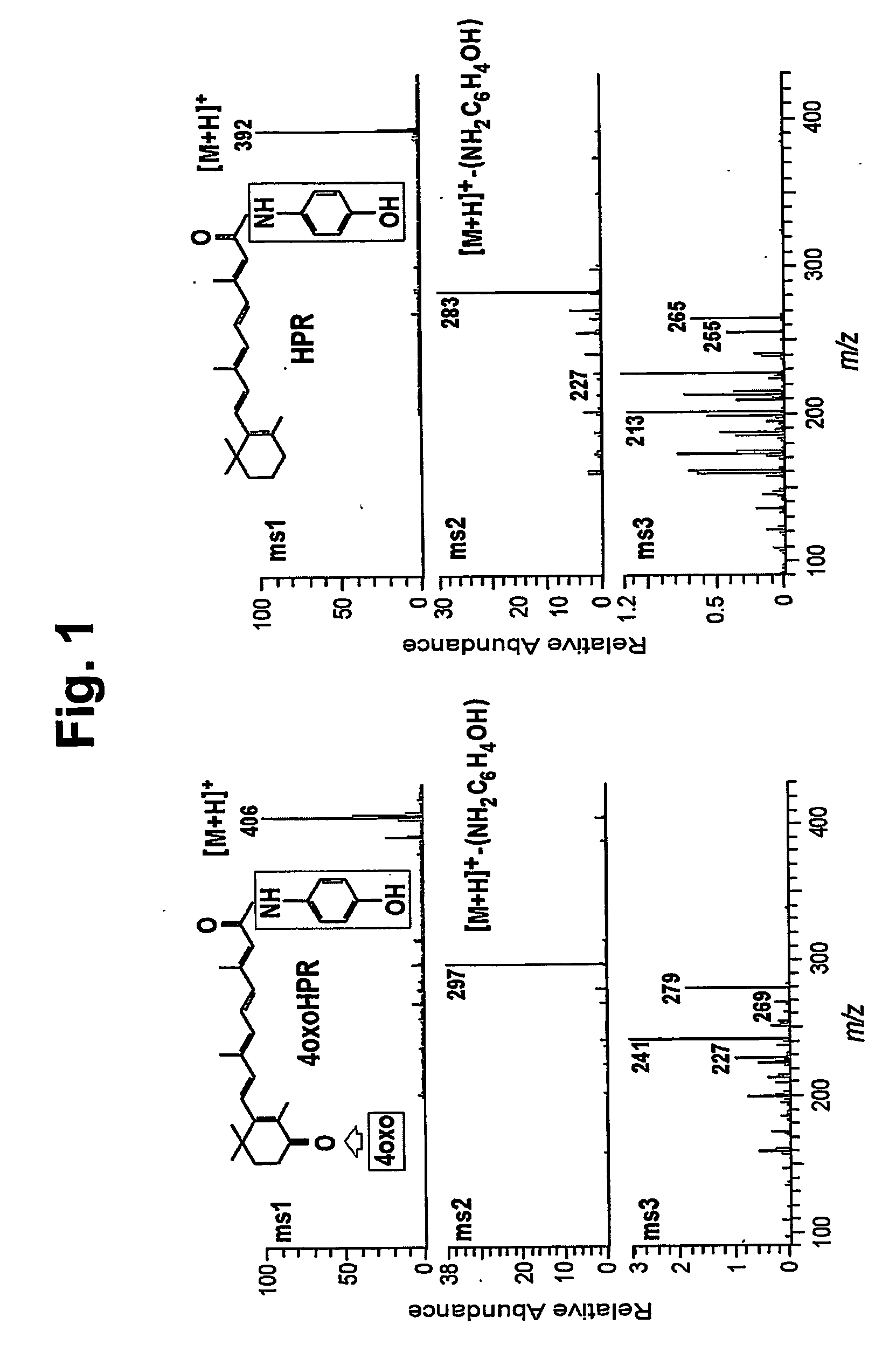4-oxo-fenretinide, administered alone and in combination with fenretinide, as preventive and therapeutic agent for cancer
a technology of fenretinide and oxo-fenretinide, which is applied in the direction of fatty acid chemical modification, drug composition, peptide/protein ingredient, etc., can solve the problems that nothing is known about the metabolism of 4-hpr in tumor cells, and achieve the effects of reducing retinol plasma levels, improving 4-hpr activity, and preventing and treating the development of malignant lesions
- Summary
- Abstract
- Description
- Claims
- Application Information
AI Technical Summary
Benefits of technology
Problems solved by technology
Method used
Image
Examples
example 1
[0019] We have previously reported that in plasma of patients treated with 4-HPR (Formelli et al., Cancer Res., 1989, 49:6149-6152) and in A2780 / HPR human ovarian carcinoma cells, obtained from A2780 cells after continuous exposure to 5 μM 4-HPR (Appierto et al., Br. J. Cancer, 2001, 84:1528-1534), besides the parent drug 4-HPR and the metabolite 4-MPR, another metabolite, more polar than the parent drug, was present. Here we describe how the metabolite can be identified.
[0020] The presence of 4-HPR and its metabolites in plasma, culture medium and tumor cell extracts was evaluated by high pressure liquid chromatography (HPLC) as previously described (Formelli et al., Cancer Res., 1989, 49:6149-6152). Briefly, plasma samples were obtained from blood collected 12h after the last daily 4-HPR dose from patients participating in a breast cancer prevention trial (Formelli et al. Cancer Res., 1989, 49: 6149-6152). A2780 / HPR -cell pellets and -media were collected 72 h after treatment wit...
example 2
[0023] For the -synthesis of 4-oxo-4-HPR, methyl 4-oxoretinoate was prepared as previously described (Curley and Carson, Drug Des. Del., 1987, 1:219-224) with slight modifications. That is, the unstable methyl 4-bromoretinoate was prepared as described and then treated with 9:1 acetone / water containing 1.5 equivalents of potassium carbonate, instead of the previously used potassium acetate, in order to generate methyl 4-hydroxyretinoate directly. The latter compound was then converted to 4-oxoretinoic acid as previously described. The 4-oxoretinoic acid (13 mg) was activated as its acid chloride and treated with 4-aminophenol using the method of Villeneuve and Chan Tet. Lett., 1997, 38:6489-6492.
[0024] Purification of the resultant 4-oxo-4-HPR by silica gel preparative thin-layer chromatography (1:1 ethyl acetate / hexane) gave a 28% yield (4.6 mg) of product as a yellow oil with the following properties: UV (methanol) λmax 371 nm (ε63,210); 1H NMR (acetone-d6) δ 1.26 (s, 6, (CH3)2),...
PUM
| Property | Measurement | Unit |
|---|---|---|
| flow rate | aaaaa | aaaaa |
| size | aaaaa | aaaaa |
| flow rate | aaaaa | aaaaa |
Abstract
Description
Claims
Application Information
 Login to View More
Login to View More - R&D
- Intellectual Property
- Life Sciences
- Materials
- Tech Scout
- Unparalleled Data Quality
- Higher Quality Content
- 60% Fewer Hallucinations
Browse by: Latest US Patents, China's latest patents, Technical Efficacy Thesaurus, Application Domain, Technology Topic, Popular Technical Reports.
© 2025 PatSnap. All rights reserved.Legal|Privacy policy|Modern Slavery Act Transparency Statement|Sitemap|About US| Contact US: help@patsnap.com



